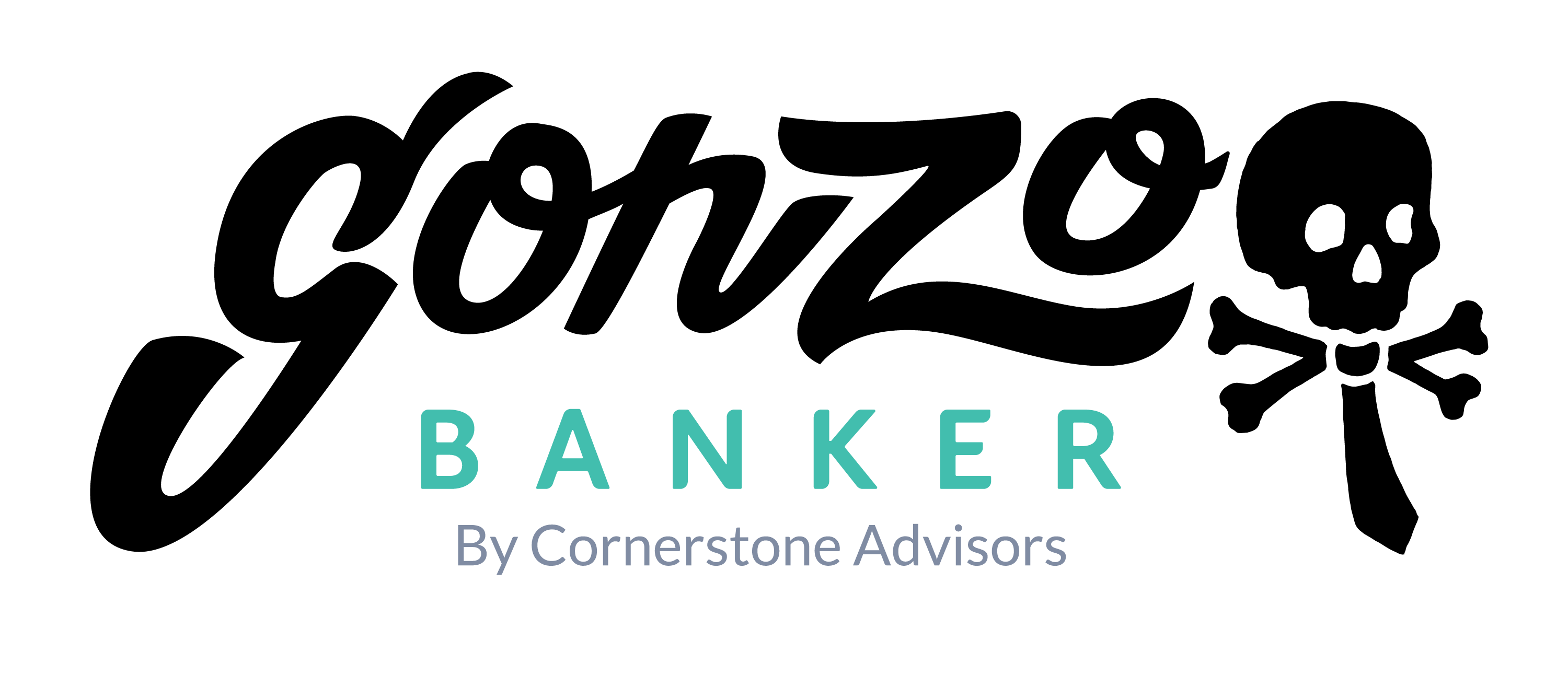
Hey Gonzo mongers, can you guess what Citibank, TCF and KeyBank have in common? They’ve all recently given free iPods to customers who would just pleeeeeaaaasssse open a new checking account with them.

Of course, there are some demographic segments that don’t want Fall Out Boy blasting our their ear drums – so other banks have responded with cold hard cash. Chase has been giving away $50 to open a checking account.
Not to be outdone, NetBank is offering 75 big Washingtons to be their loyal customer. If all this payola gets overwhelming, you may want to bookmark a fun new blog called Bank Deals. This simple blog paints the most stark picture about how hyper-competitive the quest for core deposits has become in our industry.
In the midst of an inverted yield curve, the fight for the checking account makes the battle scenes from a Mel Gibson movie look pretty wimpy.
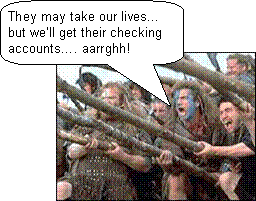
Yeah, this yield curve stinks, and we’re all hoping in some perverse way that it will change soon…recession…inflation? Just something to steepen this puppy so bankers can do what they were bred to do.
Yet while we may all dream of the shapeliest yield curve in history, bankers are also worried that this problem isn’t just a passing annoyance. Is this actually a fundamental competitive shift that’s putting a lump in our throats? In the past two years, bankers have seen an age-old gentlemen’s agreement give way to all out war. Long ago, when short rates went up and flattened the yield curve, bankers simply threw an anchor in the balance sheet, gave a nudge and a wink to each other and dragged deposit rates up slowly. (“I won’t raise rates if you don’t, Charlie.”) Sure an old codger might have complained to the branch manager that your money market rate was 1.5% below the T-bill, but pump ol’ Otis full of free coffee and doughnuts and things usually settled down.
Not today. Now that old codger storms into your branch with a vengeance. Otis has been watching CNBC all morning and surfing the net. Oh no, he’s holding one of those damn orange ING Direct mail pieces offering 4.50%. We are sooo totally hosed!

The rise of the high yield savings accounts (HYSAs) demonstrates a critical change in consumer behavior. While many consumers naturally tended to bundle their liquidity or savings account with their checking account, more and more households are separating liquidity and transactions as two separate decisions. They choose a category killer for rate and a category killer for convenience.
Where do the banks that are “pretty good” at both fit in? They hope that their local presence, personal service and sales culture help them hang on to some share of that last bastion of low cost funds – the checking account. Every bank strategic playbook across the country says one thing in all caps and bold: GET US MORE CHECKING ACCOUNTS! So, as bankers suit up and sharpen their weapons for these zero-sum battles, there are a few fundamental shifts they should keep in mind:
Shift #1: Checking accounts are growing slower than the rest of the balance sheet
For the more senior bankers in the crowd, here’s a quick snapshot of just how much things have changed from the good ol’ days. The chart below illustrates how commercial bank non-interest bearing deposits as a percentage of total deposits in the industry have gone from roughly 75% during World War II to only 17% in September 2006 – a long, steady melting ice cube of cheap deposits.
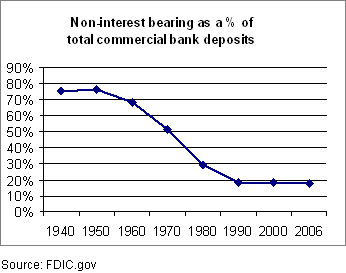
Shift #2: Checking competition could go from local to national
While money market and CD products have steadily become national markets, consumers have continued to make their checking account decisions based primarily on local branch convenience. However, many online banks believe that 2007 is the time to attack the consumer checking market. ING Direct, HSBC and E-LOAN are all gearing up new checking account offerings. ING is offering its “Electric Orange” to existing ING customers and in March to new customers. It offers a 3 percent to 5.3 percent annual rate on checking balances. USA Today recently reported that, by contrast, the average yield for all interest-bearing checking accounts on Bankrate.com is a puny 0.3 percent. In the USA Today article, ING CEO Arkadi Kuhlmann concludes, “For those at ease with online banking, we want to be their primary bank.”
EverBank, which has offered an online checking account for six years, is now offering 6.01% on checking accounts for the first three months. This FreeNet Checking account also promises that Everbank will always pay within the top five percent of competitive accounts as tracked by the Bankrate.com National Index(TM).
While there is certainly a great deal of inertia embedded in the average branch checking customer, these players have much larger household bases, stronger brands and more comfortable online users than in the failed dot.com era. With the growth of debit card, bill pay and fast Check 21 clearing, the needed comfort of the local branch may start to steadily dissipate like other legacy consumer perceptions.
Shift #3: Checking accounts are definitely segment plays
In the past decade, the focus on most checking programs has clearly gone from attracting balances to driving the courtesy pay and electronic fees. The most recent Federal Reserve survey of Consumer Finances shows a definite bifurcation in the checking market between older, more affluent checking accounts and younger, lower income fee-driven accounts.
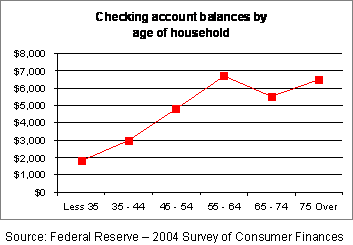
In addition, the checking account balance difference between the White/Non-Hispanic demographic segment and the Non-White/Hispanic segment remains striking.
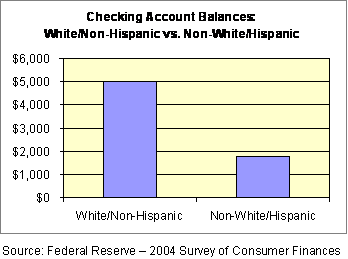
Clearly banks need different marketing plans, sales approaches and business models between the affluent balance driven and low-end fee driven accounts.
Will You Survive the Checking Account Wars?
Esteemed GonzoBankers, I wish I was brilliant enough to provide an easy answer or silver bullet to this checking account growth challenge. I spend a lot of time talking to CEOs, retail bankers and marketing execs around the country and we’re all scratching our heads faster and more frequently. As we peer into the upcoming retail environment, I’ll offer up the following tips to consider:
#1: It’s a payment account, not a checking account
With debit, ACH and bill pay volumes booming, how long will we all keep calling this product a checking account? At the heart of any future “checking” product strategy, banks need to forge a clear positioning in the emerging wild west of payments. Items such as debit and bill pay loyalty programs, micropayments, mobile payments, account-to-account transfers and funds availability will all come into play as consumers decide who has the best payments offering. It might not be long until we see this at Starbucks.
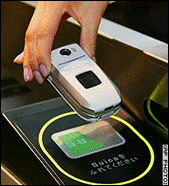
What would a shift like this do to the banker’s competitive chessboard?
#2: It’s won’t be a game of product volume – it will be a game of cumulative relationship profitability
For the past decade the checking game has been about volume, volume, volume and fees, fees, fees. How many did we open last quarter? How are fees tracking vs. our losses on overdrafts? It’s been a huge boom to bankers as courtesy pay and NSF fees now hover at $10 billion annually. Unfortunately, this mature program is starting to feel like a moving sidewalk. Banks grow new accounts 16% but then have 14% attrition for a 2% net growth. Acquisition costs are rising with heavy marketing and giveaway investments, and the upside for more fee increases seems limited. These trends are forcing bankers to question the profitability of checking accounts once again.
“We’ve dumped all the giveaway stuff and have shifted from a volume focus to a quality of account focus,” one regional bank retail executive told me a few days ago. “It made us nervous at first because we saw our volume drop, but our average account is much more solid in terms of profitability and retention.”
In the past 5 – 10 years, banks have paid little attention to product and relationship profitability. This type of analytic horsepower will be needed to craft the right checking strategies going forward.
#3: Accounts are stickier than ever due to e payments
Every retail salesperson I’ve interviewed in the past few years has lamented the difficulty of moving checking customers who have bill pay and ACH at another bank. In effect, consumers lack the motivation to move because a personal systems conversion is required. This is a classic case where “pull” vs. “push” marketing is required. While advertising “switch kits” like this Wachovia example are nice, consumers will only switch if they have a trusted individual at the bank who can shepherd the process and personally guarantee that nothing will get messed up. In addition to product knowledge, front-line retail bankers need to have unbeatable “relationship switch” knowledge. They also will need the persistence and systems to methodically chum the loan, money market and CD customer base for checking opportunities. Not easy, but necessary in today’s environment.
#4: Think of checking growth by applying the “law of small numbers”
In the current brawl for checking account relationships, it’s best to look at your checking account growth challenge at the individual banker level. Here’s some amazingly blunt shorthand for you:
This means that each retail banker has on average 300 checking accounts in the United States. 10% growth means less than three net new accounts a month. It means employees need to better network in the community, chat up the traffic in the branch and act like the E.D. Jones advisors who walk the neighborhoods to introduce themselves. It’s grass roots marketing all the way – each banker will be charged with building a more solid and vibrant portfolio of clients.
Soldier On, GonzoBankers
The age of volume-driven free checking competition has certainly reached the maturity phase in our industry. Competition has intensified and acquisition costs have skyrocketed. Bank executives will need to be more creative and analytic in how they position their “Payment” offerings in the future, while ensuring this product becomes an anchor for meaningful cross-sell activity.
Godspeed in your quest, dear retail soldiers. Aaarrrggghh!
-sw
“We will offer a broad array of products and services to our customers.”
Cornerstone Advisors has provided strategic planning advisory services to numerous high-performing, best practice mid-size banks. Armed with years of experience, a proven methodology and a proprietary database of hundreds of key bank benchmarks, we can help your institution step away from a watered-down mission statement and move toward a more focused, high performing future.
Contact us to learn more.